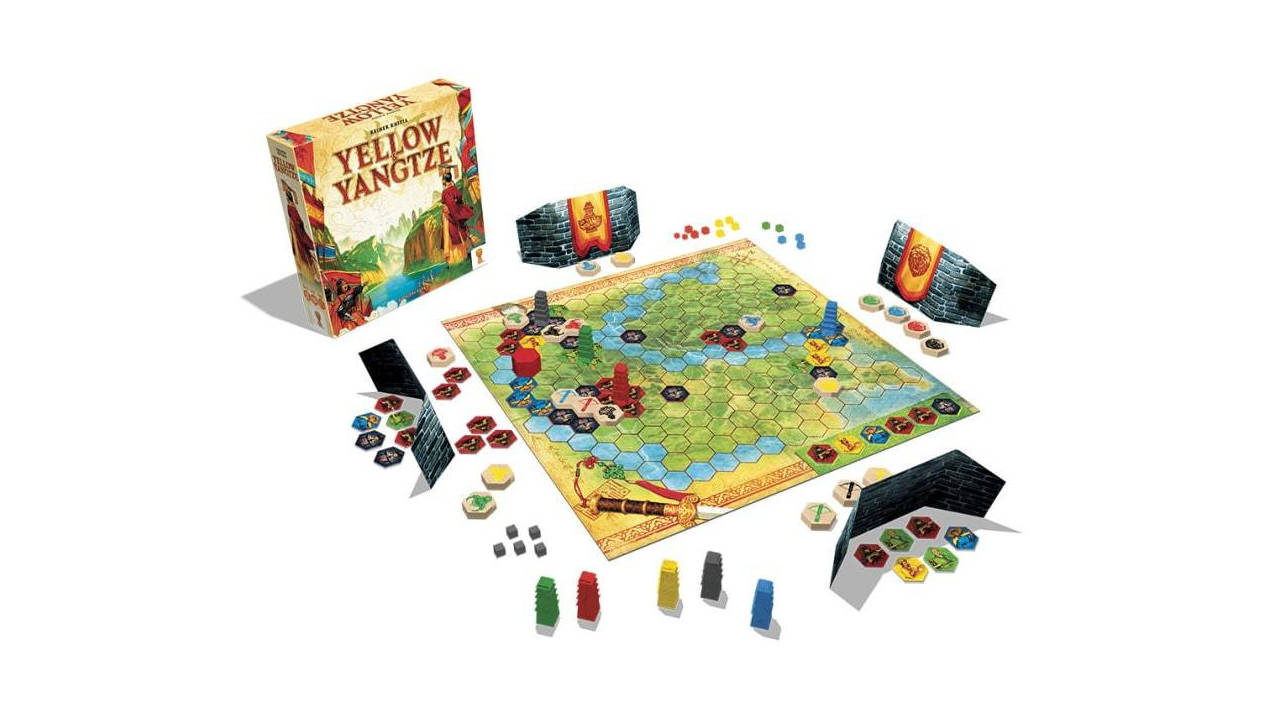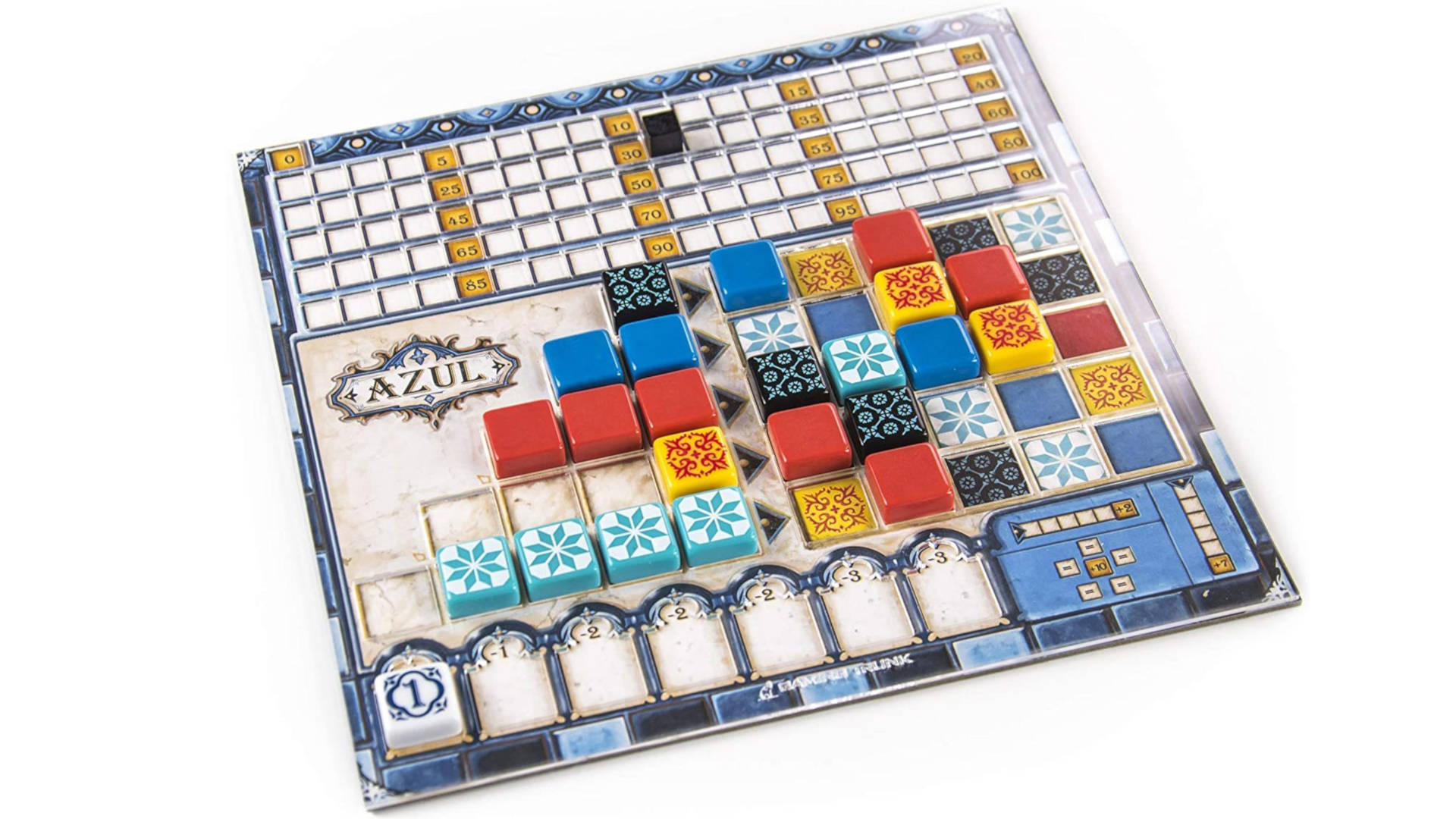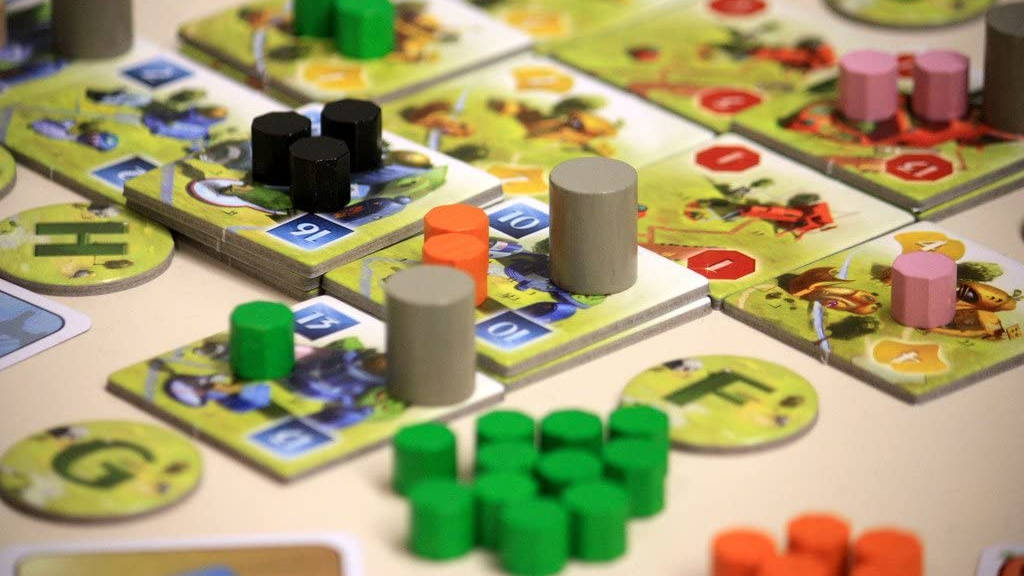Tile games have something very special about them. Their physicality brings a charm to even their most basic mechanisms of play, and their visual feedback makes for instant gratification. Few other genres of the tabletop provide as much immediate reward as seeing the expansion of your realm after plonking down a hex piece, or shifting the very boundaries of the board by dropping down a new tile.
Popular among new players of the board gaming world, their intuitive mechanics are also a treat for even the most experienced tabletop dwellers. Their involvement ranges from the simple to the extreme, and their scope for thematic alterations is huge. To guide you through the shelves-upon-shelves of tile-laying games, we’ve picked out the finest on offer, teasing out what makes them unique, enjoyable, and remarkable, compared with the scores of other games that share their fundamental system.
A quick side note: you won’t find Carcassonne on this list. Not because it’s a bad game, far from it, but because it’s a little overplayed. Everyone and their grandma knows the joys of the gallic tile-laying extravaganza – and we already count it among our best couples’ board games – so we’ve made room here for some other entries that deserve your attention.
And, if you’d prefer a wider selection, please do check out our comprehensive guide to the absolute best board games available.
But, for now: clear the table and prepare your eyeballs for sumptuous, simple design, because…
The best tile games are:
- Yellow and Yangtze
- Galaxy Trucker
- Hive
- Fjords
- Azul
- Suburbia
- Ginkgopolis
- Castles of Mad King Ludwig
- Karuba
- Indigo
 Buy now
Buy nowYellow and Yangtze
Reiner Knizia has become something of a legend in the board gaming hobby. He’s designed countless award-winning eurogames, and just his name printed on the side of a box is a sure sign that whatever lies inside is worth a peek. Yellow and Yangtze might just be his best.
It plays as a deep strategy game, but its rules are remarkably uncomplex
Taking command of one of five warring states in pre-Imperial China, you’ll compete to develop key spheres of civilisational influence: agriculture, commerce, artisanal capability and military might. Link tiles into territories to expand your influence in each sphere, judiciously distribute leaders to retain control, and construct prestigious pagodas to reap victory points. Unlike other tile-placing games, conflictual player interaction is at the heart of Yellow and Yangtze, as you butt borders with other players to overtake their settlements and steal their pagodas. In a refreshing twist, your final victory points are determined by your lowest scoring sphere of influence, forcing you to take a holistic view of the board.
And, in typical Knizia form, while Yellow and Yangtze plays as a deep strategy game, its rules and operation are remarkably uncomplex. The potential options and routes to victory available are numerous, but the actions open to you on any one turn are limited, so as not to feel overwhelming. But don’t expect any kind of historical engagement. This is very much an abstract game that ditches real-world emulation.
At its core, Yellow and Yangtze is a modernised version of Knizia’s much-loved 1997 tile-laying game Tigris and Euphrates. Both share a basic operation, and many of their rules are identical. But there are noticeable differences: Yellow and Yangtze switches out the square grid of its predecessor for hex tiles, incentivises conflicts less, and provides more board space for both movement, and forgiving empire adjustment. While the alterations are minor, they’re welcomed. Plus, Yellow and Yangtze is a lot more appealing to the eye.
 Buy now
Buy nowGalaxy Trucker
Too many tile-laying games are about territorial expansion, or using hexes to represent land. Galaxy Trucker gets this, and charges you not with expanding your empire or discovering new shores, but building a spaceship piece-by-piece, making sure it’s functional, and setting off into the vastness of space.
Game-playing is split into two distinct phases. The first has you grabbing tiles from the centre of the table, and using them to extend the hull of your ship. Make sure to appropriately line up the relevant cables and connectors, and look out for precious guns, engines, crew cabins, shield batteries, and more special tiles that will improve your ship’s utility. And, of course, be careful where you place them – it would be an awful shame for you to blow a hole in your ship because your gun was pointing inwards. But don’t dally! You’re against the clock, and must frantically assemble your craft into a functional, if janky, hull before the last grain of sand hits the hourglass’ floor.
Games par excellence: These are the best board games out there
With your ship operational, you’ll take it to the stars in the game’s second phase, which functions more like an extended scoring system than a real section of gameplay. A randomised card deck simulates the encounters of your intrepid spacefarers, and tests the resilience of your construction. Endure the pirates and asteroids that come your way, and you’ll be rewarded with some victory points. Fall victim to the blaster bolts, meanwhile, and you’ll be left watching as pieces of your ship slip into the ignominious void.
Light-hearted and a great party game, Galaxy Trucker is best enjoyed at pace. Rapidly construct your ship in a haphazard tile-placing bungle, before frantically escorting it through the dangers of space, hoping that something’s left at the end. It’s a game of boldly declaring “let’s see what happens”, before laughing at your misfortune.
 Buy now
Buy nowHive
It’s quick, it’s easy, it’s cute; Hive Pocket is as popular among tabletop veterans as it is among casual board gamers. Taking turns to place, then move, hexagonal tiles imprinted with all kinds of creepy crawlies, you’ll be competing to surround your opponent’s Queen Bee, while fending off the insectoid advances of your adversary.
As popular among tabletop veterans as it is among casual board gamers
Simple placement and move conditions, alongside distinct rules for each creature – the grasshopper can jump over creatures, for example, while the spider must move exactly three spaces each turn – make for sufficient depth, and some tense movement planning. But Hive excels for its scope. You can spend 20 minutes agonising over each turn, if you want to suck all strategic moisture from the game – or you can flippantly whizz through a match in minutes. In either case, Hive is a rip-roaring bundle of fun.
A final pointer: opt for Hive Pocket over the standard version. Its smaller pieces make for easy transport, and the included ladybug and mosquito expansion tiles will add some additional variety to your hexagonal tabletoppery. Or, if you’d prefer larger pieces, choose Hive Carbon, a black-and-white variant of the original game, which also includes the two expansions.
FJORDS
Fjords captures all the central elements of the tile-laying genre in a short, sharp, thematic package. You’re a Viking chieftain, and, like all good 8th-century warlords, colonisation is your top priority. Explore the glacial surroundings of your Scandanavian homeland, before claiming territory to rack up points.
Play is split into two phases. First comes the discovery phase, in which players take turns fitting hexes to the expanding game board, while matching various elements of terrain to keep the land visually coherent. All the while, you’ll also be looking to place down your Viking encampments on newly discovered tiles. These aren’t merely visual flavour, but essential to Fjords’ second round: the claiming phase. Extend your clan’s reach across the newly-revealed world, embarking from your encampments to claim adjacent tiles, while always on the lookout for fertile, point-scoring fields. The player to claim the most lavish lawns wins.
Social sleuth: Check out the best games like among us
A straightforward premise that can be grasped in seconds, Fjords works because of its simplicity. Carefully dictate the board’s expansion in the first phase, and tactfully palace your encampments to set yourself up with the best chance of territorial expansion in the second. Nothing too taxing, it makes for some light family fare.
And if you’re struggling to find a copy, you’re in luck. A remake has hit Kickstarter, becoming fully funded in a flash. Boasting the same central systems as the original, it comes with additional ‘rune’ mechanics, and features the artwork of Beth Sobel, most famous for her gorgeous work on Wingspan.
 Buy now
Buy nowAZUL
Azul is a tile game in more ways than one. Not only are you selecting colourful squares to arrange in pretty patterns, but the blobs of painted plastic are, so goes the game’s theme, representative of ceramic tiles used to decorate the Royal Palace of Évora. It’s your job to pick the prettiest, and arrange them on the palace’s walls for the most aesthetically pleasing, and highest point-scoring, design.
Regularly praised as one of the best gateway board games
The difficulty comes from choosing exactly how many tiles to take, and where to place them on your tiling line. Grab too many, and you’ll be punished for wasted supplies. But bide your time, and your opponents will soon run away with the prettiest mosaic in all of Portugal. Despite its elegant appearance and regular praise for being one of the best gateway board games, Azul is cutthroat in its gameplay. Choose tiles to not only serve your decorating, but to undermine that of your opponents.
At heart, though, Azul is a tranquil puzzler. Although ruthless in gameplay, few decisions are heaped upon you, making for light half-hour sessions. Placidly follow your way around its colourful, tile-laying choices, and come away a more relaxed and enlightened human being.
 Buy now
Buy nowSuburbia
Building a city is no easy feat. There’s competing benefactors to appease, tight coffers to consider, and social reputation to act as the acid test of your success. Suburbia does a fantastic job of transferring the challenges of videogame city builders to a strongly thematic, and mechanically tight, tabletop variant.
You’ll take turns selecting tiles and expanding your given borough, gradually building an economic and infrastructural engine that expands your income, and encourages population growth to your growing town. Accrue more money to purchase more buildings, but be wary of what you buy. Less desirable buildings may impinge your reputation if placed poorly, and you’ll have to be careful to stick residential, commercial, civic, and industrial buildings in discrete areas. Balance your monetary acquisition with reputational gain, and plan your borough’s growth as best you can. With varying sets of buildings included in each game, you’re sure to play a different match of Suburbia every time you pick up its pieces.
They’re all right: These are the best kids’ board games
But the game’s strongest asset is its thematic commitment, with each tile carrying particular abilities and effects that replicate their real-life counterparts. A landfill tile might increase the income of your metropolis, but should be placed away from residential areas to avoid upsetting the citizens of suburbia. Car parks will only be effective near large business districts, and community parks can be used as a buffer zone between belching industrial factories and quiet housing zones. The theme isn’t painted on as an afterthought, but ingrained into play.
Although usually played between two to four people, it also includes a solo variant for those occasions when you’re simply desperate for some industrial expansion. An automatic ruleset replicates the actions of another player, and, although simplistic and no match for the variety or skill of a human, it captures the essence of the game. Take Suburbia for a spin if you fancy bringing SimCity to the tabletop, and grab the collector’s edition for extra tiles and expansions.
 Buy now
Buy nowGinkgopolis
Mixing tile-laying with elements of tableau building and worker placement, no one can claim Ginkgopolis isn’t unique. Set in a desolate future, in which the earth’s natural resources have been all but depleted, and habitable land exhausted, you take the role of an urban planner who must chart a new era in sustainable city growth.
Everyone works on the same city to make the most productive settlement
Unlike other games on this list, while modular tiles make up the central game board, card-playing is the co-primary mechanism of play. Each turn, players simultaneously play a card from their hand, choosing to collect tiles, construct various buildings, or grab resources to fuel further expansion. But you’re not playing alone. Everyone is working on the same city, trying to create the most productive settlement, while scoring some rewards for themselves along the way.
A mesh of mechanics, Ginkgpolis challenges you to finely balance point acquisition, territory expansion, and engine-building. You’ll be improving the burgeoning city, while opportunistically ducking out of your altruistic duties to scupper your opponents, or grab some victory points at the cost of efficient growth. Bear in mind that its layers of rules can take some getting used to. Grab this one to play with a strong group of experienced board game players.
 Buy now
Buy nowCASTLES OF MAD KING LUDWIG
King Ludwig II of Bavaria was quite the monarch. Obsessed with opera, swooning over swans, and no stranger to the odd military engagement, it’s his penchant for architectural extravagance that has defined his legacy. Neuschwanstein Castle might be the closest thing to a real-life fairytale setting that we’ll ever see, and, while we have the good King himself to thank for the architectural spectacle of the real thing, Castles of Mad King Ludwig aptly brings all its over-the-top artistic extravagance to the tabletop.
Starting with a humble foyer and a pile of cash, players take turns expanding their castle with dining halls, bed chambers, corridors, living rooms and more, trying to grab the highest-scoring rooms, connect entranceways, and complete bonus objectives for extra points. Connect certain room types for combos, and face penalties for ill-considered placements. You’ll forever be planning your next decorating choice, while assessing how your expansion might upset the potential growth of other players.
Tabletop for all: Our picks of the best family board games
Rather than distributing tiles by chance, or in a clamouring free-for-all, one player will take the role of Master Builder, setting prices for each room to be purchased by the other players, and picking from the leftovers for their own construction project. The designated Master Builder rotates each round, making for some shrewd price-setting. Set room prices too low and you’ll reward your competitors with a bargain, but price them too high and no-one will pay you a dime.
Alongside its gorgeous tile art, and the sheer novelty of seeing wacky castle interiors spring up in front of you, Castles of Mad King Ludwig excels for its player interaction. From the placement of your chateau hallways to the purchasing of new tiles, every step stands in relation to others. Be prepared to really get into your architectural groove, though, as games can last well over an hour.
 Buy now
Buy nowKaruba
A tile-laying game that isn’t about building a settlement or grabbing land, Karuba embraces exploration. Leading a team of intrepid explorers, you’ll be placing down tiles to create a path from the frightening depths of the jungle to the treasure-filled vaults of nearby temples, leading your companions to safety (and riches).
Karuba’s main appeal is undoubtedly its speed
The struggle comes from balancing movement with path-creation. On any turn, you can choose to discard the tile in your hand, and move your explorer along your created pathway, inching them closer to their objective. Choose wisely, though. A fully constructed path will mean nothing if all your explorers have been left behind at base camp, but moving your team at every opportunity will sacrifice the best tiles, leaving you with a path that might be contiguous, but so contorted that it takes an age to traverse.
Karuba’s main appeal is undoubtedly its speed of play. A game can be wrapped up in a quick 20 minutes, and the rules are simple enough to explain in a flash. There’s enough meat to keep you on your toes, and rules are sufficiently intuitive that even the most tabletop-illiterate players will have a grand time.
 Buy now
Buy nowINDIGO
Indigo is a path-building tile game that challenges you to construct channels through which precious gemstones can be moved. Preferably, you’ll construct these lanes to connect the stones with your personal and shared gateways, pocketing the shiny rocks for points.
Gameplay is simple enough. Players take turns placing route tiles to extend the board’s pathways, ensuring that each forms a contiguous route with their adjacent spaces. Target the most valuable stones on the board, because when all of them have been swept up, the player with the most valuable hoard is declared the winner.
Remote rules: Check out the best online board games
Indigo works so effectively because of its player interaction. All players share the routes on the board, and your efforts to direct a pathway to your gateway might suddenly be cut short by a competitor who switches the track in their favour. Confer with other players to thwart a particularly troublesome opponent, or feign a helping hand before switching the path in your gateway’s direction. Often compared to path-building game Tsuro, Indigo comes out on top for its ludicrously simple rule system that dispenses with player elimination, and its gosh-darn pretty board design.
Source: Wargamer





